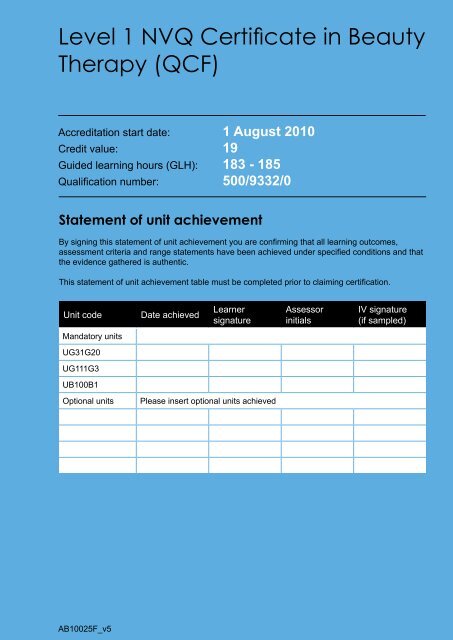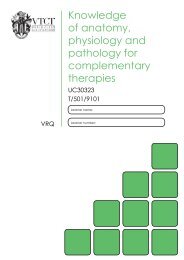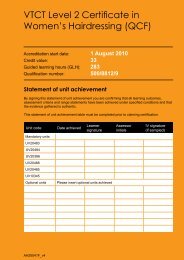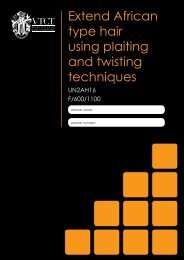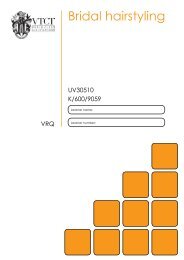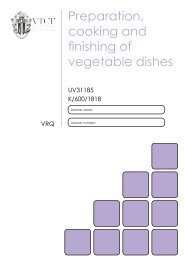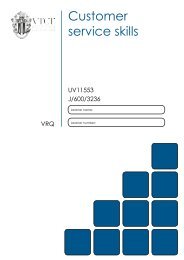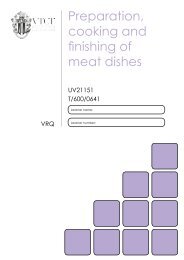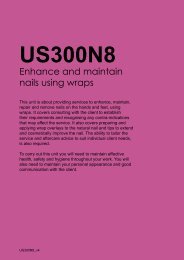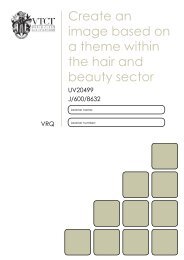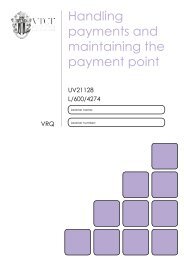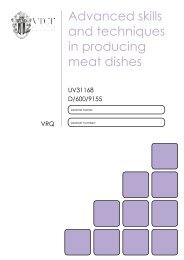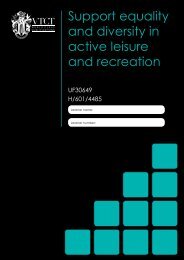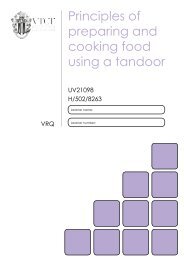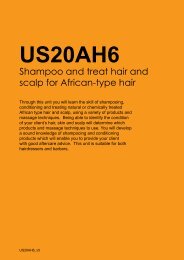Level 1 NVQ Certificate in Beauty Therapy (QCF) - VTCT
Level 1 NVQ Certificate in Beauty Therapy (QCF) - VTCT
Level 1 NVQ Certificate in Beauty Therapy (QCF) - VTCT
Create successful ePaper yourself
Turn your PDF publications into a flip-book with our unique Google optimized e-Paper software.
<strong>Level</strong> 1 <strong>NVQ</strong> <strong>Certificate</strong> <strong>in</strong> <strong>Beauty</strong><br />
<strong>Therapy</strong> (<strong>QCF</strong>)<br />
Accreditation start date: 1 August 2010<br />
Credit value: 19<br />
Guided learn<strong>in</strong>g hours (GLH): 183 - 185<br />
Qualification number: 500/9332/0<br />
Statement of unit achievement<br />
By sign<strong>in</strong>g this statement of unit achievement you are confirm<strong>in</strong>g that all learn<strong>in</strong>g outcomes,<br />
assessment criteria and range statements have been achieved under specified conditions and that<br />
the evidence gathered is authentic.<br />
This statement of unit achievement table must be completed prior to claim<strong>in</strong>g certification.<br />
Unit code Date achieved<br />
Mandatory units<br />
UG31G20<br />
UG111G3<br />
UB100B1<br />
AB10025F_v5<br />
Learner<br />
signature<br />
Optional units Please <strong>in</strong>sert optional units achieved<br />
Assessor<br />
<strong>in</strong>itials<br />
IV signature<br />
(if sampled)
2<br />
The qualification<br />
Introduction National Occupational Standards (NOS)<br />
The <strong>Level</strong> 1 <strong>NVQ</strong> <strong>Certificate</strong> <strong>in</strong> <strong>Beauty</strong> <strong>Therapy</strong><br />
(<strong>QCF</strong>) is based on National Occupational<br />
Standards (NOS).<br />
This qualification will provide you with the<br />
basic knowledge and skills <strong>in</strong> preparation for<br />
a career as a beauty therapist. Throughout<br />
this qualification you will ensure responsibility<br />
to reduce risks to health and safety, prepare<br />
and ma<strong>in</strong>ta<strong>in</strong> salon treatment work areas and<br />
contribute to the development of effective<br />
work<strong>in</strong>g relationships.<br />
You will be supervised by technical staff and<br />
assessed on your competence.<br />
This qualification has been mapped to the<br />
relevant NOS, and is accredited on the<br />
Qualifications and Credit Framework (<strong>QCF</strong>).<br />
This qualification is approved and supported by<br />
the Hairdress<strong>in</strong>g and <strong>Beauty</strong> Industry Authority<br />
(HABIA), the standard sett<strong>in</strong>g body for hair,<br />
beauty, nails and spa qualifications.
Progression<br />
This qualification provides a sound platform for<br />
further learn<strong>in</strong>g or tra<strong>in</strong><strong>in</strong>g as a beauty therapist.<br />
This qualification provides progression<br />
opportunities to the follow<strong>in</strong>g <strong>VTCT</strong><br />
qualifications:<br />
• <strong>Level</strong> 2 <strong>NVQ</strong> Diploma <strong>in</strong> <strong>Beauty</strong> <strong>Therapy</strong><br />
General (<strong>QCF</strong>)<br />
• <strong>Level</strong> 2 <strong>NVQ</strong> Diploma <strong>in</strong> <strong>Beauty</strong> <strong>Therapy</strong><br />
Make-Up (<strong>QCF</strong>)<br />
Progression opportunities also exist <strong>in</strong> the<br />
form of specialist <strong>VTCT</strong> vocationally related<br />
qualifications at <strong>Level</strong> 2.<br />
3
4<br />
Qualification structure<br />
Total credits required - 19 (m<strong>in</strong>imum)<br />
All mandatory units must be completed.<br />
Mandatory units - 11 credits<br />
<strong>VTCT</strong> unit<br />
code<br />
Ofqual unit<br />
reference<br />
UG31G20 A/601/5867<br />
UG111G3 J/600/1258<br />
UB100B1 R/600/9086<br />
Optional units - 8 (m<strong>in</strong>imum) credits<br />
<strong>VTCT</strong> unit<br />
code<br />
Ofqual unit<br />
reference<br />
Unit title Credit value GLH<br />
Ensure responsibility for actions to reduce<br />
risks to health and safety<br />
Contribute to the development of effective<br />
work<strong>in</strong>g<br />
Prepare and ma<strong>in</strong>ta<strong>in</strong> salon treatment<br />
work areas<br />
4 38<br />
4 40<br />
3 27<br />
Unit title Credit value GLH<br />
UB100B2 Y/600/8747 Assist with facial sk<strong>in</strong> care treatments 4 40<br />
UB100B3 F/600/8919 Assist with day make-up 4 40<br />
UG111G2 F/600/1257 Assist with salon reception duties 4 38<br />
UB100N1 L/600/8924 Assist with nail services 4 40
Guidance on assessment<br />
This book conta<strong>in</strong>s the mandatory units that make up this qualification. Optional units will be<br />
provided <strong>in</strong> additional booklets. Where <strong>in</strong>dicated, <strong>VTCT</strong> will provide assessment materials.<br />
Assessments may be <strong>in</strong>ternal or external. The method of assessment is <strong>in</strong>dicated <strong>in</strong> each unit.<br />
Internal assessment<br />
(any requirements will be shown <strong>in</strong> the unit)<br />
Assessment is set, marked and <strong>in</strong>ternally<br />
verified by the centre to clearly demonstrate<br />
achievement of the learn<strong>in</strong>g outcomes.<br />
Assessment is sampled by <strong>VTCT</strong> external<br />
verifiers.<br />
External assessment<br />
(any requirements will be shown <strong>in</strong> the unit)<br />
Externally assessed question papers<br />
completed electronically will be set and marked<br />
by <strong>VTCT</strong>.<br />
Externally assessed hard-copy question papers<br />
will be set by <strong>VTCT</strong>, marked by centre staff and<br />
sampled by <strong>VTCT</strong> external verifiers.<br />
Assessment expla<strong>in</strong>ed<br />
<strong>VTCT</strong> courses are assessed and verified by<br />
centre staff. Work will be set to improve your<br />
practical skills, knowledge and understand<strong>in</strong>g.<br />
For practical elements, you will be observed<br />
by your assessor. All your work must be<br />
collected <strong>in</strong> a portfolio of evidence and crossreferenced<br />
to requirements listed <strong>in</strong> this record<br />
of assessment book.<br />
Your centre will have an <strong>in</strong>ternal verifier whose<br />
role is to check that your assessment and<br />
evidence is valid and reliable and meets <strong>VTCT</strong><br />
and regulatory requirements.<br />
An external verifier, appo<strong>in</strong>ted by <strong>VTCT</strong>, will<br />
visit your centre to sample and quality-check<br />
assessments, the <strong>in</strong>ternal verification process<br />
and the evidence gathered. You may be<br />
asked to attend on a different day from usual if<br />
requested by the external verifier.<br />
This record of assessment book is your<br />
property and must be <strong>in</strong> your possession when<br />
you are be<strong>in</strong>g assessed or verified. It must be<br />
kept safe. In some cases your centre will be<br />
required to keep it <strong>in</strong> a secure place. You and<br />
your course assessor will together complete<br />
this book to show achievement of all learn<strong>in</strong>g<br />
outcomes, assessment criteria and ranges.<br />
5
6<br />
Creat<strong>in</strong>g a portfolio of evidence<br />
As part of this qualification you are required to<br />
produce a portfolio of evidence. A portfolio will<br />
confirm the knowledge, understand<strong>in</strong>g and skills<br />
that have been learned. It may be <strong>in</strong> electronic<br />
or paper format.<br />
Your assessor will provide guidance on how to<br />
prepare the portfolio of evidence and how to<br />
show practical achievement, and understand<strong>in</strong>g<br />
of the knowledge required to successfully<br />
complete the qualification. It is this booklet<br />
along with the portfolio of evidence that will<br />
serve as the prime source of evidence for this<br />
qualification.<br />
Evidence <strong>in</strong> the portfolio may take the follow<strong>in</strong>g<br />
forms:<br />
• Observed work<br />
• Witness statements<br />
• Audio-visual media<br />
• Evidence of prior learn<strong>in</strong>g or atta<strong>in</strong>ment<br />
• Written questions<br />
• Oral questions<br />
• Assignments<br />
• Case studies<br />
All evidence should be documented <strong>in</strong> the<br />
portfolio and cross referenced to the outcomes.<br />
Construct<strong>in</strong>g the portfolio of evidence should not<br />
be left to the end of the course.<br />
Many frequently asked questions and other<br />
useful <strong>in</strong>formation are detailed <strong>in</strong> the <strong>VTCT</strong><br />
Candidate’s Handbook, which is available on<br />
the <strong>VTCT</strong> website at www.vtct.org.uk/students.<br />
Other questions should be addressed to the<br />
tutor, lecturer or assessor.
Unit assessment methods<br />
This section provides an overview of the assessment methods that make up each unit <strong>in</strong> this<br />
qualification. Detailed <strong>in</strong>formation on assessment is provided <strong>in</strong> each unit.<br />
Mandatory units<br />
<strong>VTCT</strong> unit<br />
code<br />
UG31G20<br />
UG111G3<br />
UB100B1<br />
Optional units<br />
<strong>VTCT</strong> unit<br />
code<br />
UB100B2<br />
Unit title<br />
Ensure responsibility for actions to<br />
reduce risks to health and safety<br />
Contribute to the development of<br />
effective work<strong>in</strong>g<br />
Prepare and ma<strong>in</strong>ta<strong>in</strong> salon<br />
treatment work areas<br />
Unit title<br />
Assist with facial sk<strong>in</strong> care<br />
treatments<br />
External Internal<br />
Question<br />
paper(s)<br />
Observations Assignments<br />
0 � �<br />
0 � �<br />
1 � �<br />
External Internal<br />
Question<br />
paper(s)<br />
Observations Assignments<br />
1 � �<br />
UB100B3 Assist with day make-up 1 � �<br />
UG111G2 Assist with salon reception duties 0 � �<br />
UB100N1 Assist with nail services 1 � �<br />
7
8<br />
Unit glossary<br />
<strong>VTCT</strong> product<br />
code<br />
Description<br />
All units are allocated a unique <strong>VTCT</strong> product code for identification purposes.<br />
This code should be quoted <strong>in</strong> all queries and correspondence to <strong>VTCT</strong>.<br />
Unit title The title clearly <strong>in</strong>dicates the focus of the unit.<br />
National<br />
Occupational<br />
Standards<br />
(NOS)<br />
<strong>Level</strong><br />
Credit value<br />
Guided<br />
Learn<strong>in</strong>g Hours<br />
(GLH)<br />
Observations<br />
Learn<strong>in</strong>g<br />
outcomes<br />
Evidence<br />
requirements<br />
Maximum<br />
service times<br />
Observation<br />
outcome<br />
Knowledge<br />
outcome<br />
Assessment<br />
criteria<br />
Range<br />
NOS describe the skills, knowledge and understand<strong>in</strong>g needed to undertake a<br />
particular task or job to a nationally recognised level of competence.<br />
<strong>Level</strong> is an <strong>in</strong>dication of the demand of the learn<strong>in</strong>g experience; the depth<br />
and/or complexity of achievement and <strong>in</strong>dependence <strong>in</strong> achiev<strong>in</strong>g the<br />
learn<strong>in</strong>g outcomes. There are 9 levels of achievement with<strong>in</strong> the Qualifications<br />
and Credit Framework (<strong>QCF</strong>).<br />
This is the number of credits awarded upon successful achievement of all unit<br />
outcomes. Credit is a numerical value that represents a means of recognis<strong>in</strong>g,<br />
measur<strong>in</strong>g, valu<strong>in</strong>g and compar<strong>in</strong>g achievement.<br />
GLH is an estimate of the time allocated to teach, <strong>in</strong>struct, assess and<br />
support learners throughout a unit. Learner <strong>in</strong>itiated private study, preparation<br />
and mark<strong>in</strong>g of formative assessment is not taken <strong>in</strong>to account.<br />
This <strong>in</strong>dicates the m<strong>in</strong>imum number of observations required to achieve the<br />
unit.<br />
The learn<strong>in</strong>g outcomes are the most important component of the unit; they set<br />
out what is expected <strong>in</strong> terms of know<strong>in</strong>g, understand<strong>in</strong>g and practical<br />
ability as a result of the learn<strong>in</strong>g process. Learn<strong>in</strong>g outcomes are the results<br />
of learn<strong>in</strong>g.<br />
This section provides guidel<strong>in</strong>es on how evidence must be gathered.<br />
The maximum time specified by Habia <strong>in</strong> which a particular service or<br />
practical element must be completed.<br />
An observation outcome details the practical tasks that must be completed to<br />
achieve the unit.<br />
A knowledge outcome details the theoretical requirements of a unit that must<br />
be evidenced through oral question<strong>in</strong>g, a mandatory written question paper or<br />
portfolio of evidence.<br />
Assessment criteria set out what is required, <strong>in</strong> terms of achievement, to meet<br />
a learn<strong>in</strong>g outcome. The assessment criteria and learn<strong>in</strong>g outcomes are the<br />
components that <strong>in</strong>form the learn<strong>in</strong>g and assessment that should take place.<br />
Assessment criteria def<strong>in</strong>e the standard expected to meet learn<strong>in</strong>g outcomes.<br />
The range <strong>in</strong>dicates what must be covered. Ranges must be practically<br />
demonstrated <strong>in</strong> parallel to the unit’s observation outcomes.
UG31G20<br />
Ensure responsibility for actions to<br />
reduce risks to health and safety<br />
This unit is about provid<strong>in</strong>g you with the knowledge,<br />
understand<strong>in</strong>g and skills to be responsible for health and<br />
safety <strong>in</strong> the workplace.<br />
This unit is for everyone at work (whether paid, unpaid, full<br />
or part-time). It is about be<strong>in</strong>g aware of the ma<strong>in</strong> risks <strong>in</strong><br />
your workplace and know<strong>in</strong>g how to identify and deal with<br />
them.<br />
UG31G20_v7
NOS<br />
G20<br />
<strong>Level</strong><br />
Credit value<br />
GLH<br />
3<br />
4<br />
38<br />
Observations<br />
2<br />
External paper(s)<br />
0
Ensure responsibility for actions to<br />
reduce risks to health and safety<br />
Learn<strong>in</strong>g outcomes Evidence requirements<br />
On completion of this unit you will:<br />
1. Be able to identify the hazards and evaluate<br />
the risks <strong>in</strong> the workplace<br />
2. Be able to reduce the risks to health and<br />
safety <strong>in</strong> the workplace<br />
3. Know how to reduce risks to health and<br />
safety <strong>in</strong> the workplace<br />
1. A variety of assessment methods should be<br />
used to confirm competence. Assessment<br />
of knowledge should be <strong>in</strong>tegrated with<br />
the assessment of performance wherever<br />
possible and appropriate.<br />
2. Your assessor will observe you on two<br />
separate occasions. All evidence must be<br />
derived from performance <strong>in</strong> the workplace<br />
with no exceptions. Therefore no simulated<br />
work<strong>in</strong>g conditions have been specified <strong>in</strong><br />
this Assessment Strategy as the outcomes<br />
can be demonstrated by a comb<strong>in</strong>ation of<br />
other assessment methods drawn from:<br />
• direct observation of the candidate <strong>in</strong> the<br />
workplace<br />
• witness testimony by colleagues and l<strong>in</strong>e<br />
managers of the candidate’s successful<br />
performance of activities <strong>in</strong> the workplace<br />
• documentary and other product based<br />
evidence<br />
• a personal report by the candidate<br />
endorsed by colleagues<br />
• questions<br />
• discussion<br />
• professional discussion.<br />
3. There is no external paper requirement for<br />
this unit.<br />
UG31G20<br />
11
12<br />
Achiev<strong>in</strong>g observations<br />
and range<br />
Achiev<strong>in</strong>g observation outcomes<br />
Your assessor will observe your performance<br />
of practical tasks. The m<strong>in</strong>imum number<br />
of observations required is <strong>in</strong>dicated <strong>in</strong> the<br />
evidence requirements section of this unit.<br />
Criteria may not always naturally occur dur<strong>in</strong>g<br />
a practical observation. In such <strong>in</strong>stances you<br />
will be asked questions to demonstrate your<br />
competence <strong>in</strong> this area. Your assessor will<br />
document the criteria that have been achieved<br />
through oral question<strong>in</strong>g.<br />
Your assessor will sign off an outcome when all<br />
criteria have been competently achieved <strong>in</strong> a<br />
s<strong>in</strong>gle client service.<br />
Achiev<strong>in</strong>g range<br />
There are no range statements that apply to this<br />
unit.<br />
UG31G20<br />
Maximum service times<br />
There are no maximum service times that apply<br />
to this unit.
Outcome 1<br />
You can:<br />
a. Identify workplace <strong>in</strong>structions that are<br />
relevant to you and your job role<br />
b. Identify work<strong>in</strong>g practices and hazards <strong>in</strong><br />
the workplace that could be harmful<br />
c. Evaluate the hazards and prioritise <strong>in</strong> risk<br />
order<br />
d. Report hazard(s) to the responsible person*<br />
*May be assessed through oral question<strong>in</strong>g.<br />
Observations<br />
Be able to identify the hazards and evaluate the risks <strong>in</strong> the<br />
workplace<br />
Observation<br />
Criteria questioned orally<br />
Date achieved<br />
Portfolio reference<br />
Learner signature<br />
Assessor <strong>in</strong>itials<br />
1 2<br />
UG31G20<br />
13
14<br />
Outcome 2<br />
Be able to reduce the risks to health and safety <strong>in</strong> the<br />
workplace<br />
You can:<br />
a. Perform work activities at own level of<br />
competence <strong>in</strong> accordance with identified<br />
health and safety:<br />
- workplace policies<br />
- <strong>in</strong>structions and procedures<br />
- suppliers’ and manufacturers’<br />
<strong>in</strong>formation<br />
- relevant legal requirements<br />
b. Manage hazards <strong>in</strong> accordance with<br />
workplace <strong>in</strong>structions and legal<br />
requirements<br />
c. Report any differences between workplace<br />
<strong>in</strong>structions and supplier/manufacturer<br />
<strong>in</strong>structions*<br />
*May be assessed through oral question<strong>in</strong>g.<br />
Observation 1 2<br />
Criteria questioned orally<br />
Date achieved<br />
Portfolio reference<br />
Learner signature<br />
Assessor <strong>in</strong>itials<br />
UG31G20
Achiev<strong>in</strong>g knowledge outcomes<br />
You will be guided by your tutor and assessor<br />
on the evidence that needs to be produced.<br />
Your knowledge and understand<strong>in</strong>g will be<br />
assessed us<strong>in</strong>g the assessment methods listed<br />
below:<br />
• Observed work<br />
• Witness statements<br />
• Audio-visual media<br />
• Evidence of prior learn<strong>in</strong>g or atta<strong>in</strong>ment<br />
• Written questions<br />
• Oral questions<br />
• Assignments<br />
• Case studies<br />
Develop<strong>in</strong>g knowledge<br />
Where possible your assessor will <strong>in</strong>tegrate<br />
knowledge outcomes <strong>in</strong>to practical observations<br />
through oral question<strong>in</strong>g.<br />
UG31G20 15
16<br />
Knowledge<br />
Outcome 3<br />
Know how to reduce risks to health and safety <strong>in</strong> the workplace<br />
You can:<br />
a. Expla<strong>in</strong> your responsibility <strong>in</strong> rema<strong>in</strong><strong>in</strong>g alert to hazards and risks<br />
b. Describe own responsibilities and scope for action <strong>in</strong> controll<strong>in</strong>g<br />
risk<br />
c. Expla<strong>in</strong> the importance of adher<strong>in</strong>g to health and safety policies<br />
and practices<br />
d. Describe where and when to get additional health and safety<br />
assistance<br />
e. Describe the importance of personal presentation and behaviour <strong>in</strong><br />
ma<strong>in</strong>ta<strong>in</strong><strong>in</strong>g health and safety <strong>in</strong> the workplace<br />
* Assessor <strong>in</strong>itials to be <strong>in</strong>serted if orally questioned.<br />
Requirements highlighted <strong>in</strong> white are assessed <strong>in</strong> the external paper.<br />
UG31G20<br />
Portfolio reference /<br />
Assessor <strong>in</strong>itials*
UG111G3<br />
Contribute to the development<br />
of effective work<strong>in</strong>g<br />
This unit is about form<strong>in</strong>g good relationships with clients<br />
<strong>in</strong> a way that promotes goodwill and trust, be<strong>in</strong>g able to<br />
work effectively when support<strong>in</strong>g your colleagues and us<strong>in</strong>g<br />
opportunities for learn<strong>in</strong>g that happens with<strong>in</strong> your job role.<br />
UG111G3_v6
NOS<br />
<strong>Level</strong><br />
Credit value<br />
GLH<br />
G3<br />
1<br />
4<br />
40<br />
Observations<br />
3<br />
External paper(s)<br />
0<br />
© Habia
Contribute to the development<br />
of effective work<strong>in</strong>g<br />
Learn<strong>in</strong>g outcomes Evidence requirements<br />
On completion of this unit you will:<br />
1. Be able to develop effective work<strong>in</strong>g<br />
relationships with clients and colleagues<br />
2. Be able to develop yourself with<strong>in</strong> the job<br />
role<br />
3. Understand the salon’s and legal<br />
requirements<br />
4. Understand communication methods<br />
5. Understand procedures and targets<br />
6. Understand how to improve own<br />
performance<br />
7. Understand how to work with others<br />
1. Simulation is not allowed for any<br />
performance evidence with<strong>in</strong> this unit.<br />
2. You must practically demonstrate <strong>in</strong> your<br />
work situation that you have met the<br />
standards for contribut<strong>in</strong>g to effective<br />
work<strong>in</strong>g relationships.<br />
3. Your assessor will observe these aspects of<br />
your performance on at least 3 occasions,<br />
2 of which will cover your <strong>in</strong>teraction with<br />
clients and one of which will cover your<br />
<strong>in</strong>teraction with colleagues.<br />
4. From the range you must show that you<br />
have:<br />
• participated <strong>in</strong> all the types of learn<strong>in</strong>g<br />
opportunities listed.<br />
5. Although a large part of the evidence of<br />
your performance will be gathered from<br />
the observations made by your assessor,<br />
you will need to produce other evidence<br />
to support your performance as described<br />
below:<br />
• You should provide supplementary<br />
evidence to support consistency of your<br />
performance with colleagues and clients.<br />
• For Outcome 2, you should collect<br />
documentary evidence to show you have<br />
participated <strong>in</strong> self development activities<br />
over a period of time.<br />
6. There is no external paper requirement for<br />
this unit.<br />
UG111G3<br />
19
20<br />
Achiev<strong>in</strong>g observations<br />
and range<br />
Achiev<strong>in</strong>g observation outcomes<br />
Your assessor will observe your performance<br />
of practical tasks. The m<strong>in</strong>imum number<br />
of observations required is <strong>in</strong>dicated <strong>in</strong> the<br />
evidence requirements section of this unit.<br />
Criteria may not always naturally occur dur<strong>in</strong>g<br />
a practical observation. In such <strong>in</strong>stances you<br />
will be asked questions to demonstrate your<br />
competence <strong>in</strong> this area. Your assessor will<br />
document the criteria that have been achieved<br />
through oral question<strong>in</strong>g.<br />
Your assessor will sign off an outcome when all<br />
criteria have been competently achieved <strong>in</strong> a<br />
s<strong>in</strong>gle client service.<br />
Achiev<strong>in</strong>g range<br />
The range section <strong>in</strong>dicates what must<br />
be covered. Ranges must be practically<br />
demonstrated as part of an observation. Your<br />
assessor will document the portfolio reference<br />
once a range has been competently achieved.<br />
UG111G3<br />
Maximum service times<br />
There are no maximum service times that apply<br />
to this unit.
Outcome 1<br />
You can:<br />
a. Communicate with clients and colleagues<br />
<strong>in</strong> a manner which promotes goodwill, trust<br />
and ma<strong>in</strong>ta<strong>in</strong>s confidentiality*<br />
b. Handle client belong<strong>in</strong>gs with care and<br />
return them when required<br />
c. Refer any client concerns promptly to the<br />
relevant person*<br />
d. Ma<strong>in</strong>ta<strong>in</strong> client comfort and care to the<br />
satisfaction of the client<br />
e. Ask politely for help and <strong>in</strong>formation from<br />
colleagues when necessary<br />
f. Respond will<strong>in</strong>gly, courteously and <strong>in</strong> a<br />
timely manner to requests for assistance,<br />
which supports the smooth runn<strong>in</strong>g of the<br />
salon<br />
g. Report problems likely to affect salon<br />
services to the relevant person*<br />
h. Meet the salon’s standards for appearance<br />
and behaviour<br />
*May be assessed through oral question<strong>in</strong>g.<br />
Observations<br />
Be able to develop effective work<strong>in</strong>g relationships with clients<br />
and colleagues<br />
Observation 1 2 3<br />
Criteria questioned orally<br />
Date achieved<br />
Portfolio reference<br />
Learner signature<br />
Assessor <strong>in</strong>itials<br />
UG111G3<br />
21
22<br />
© Habia<br />
Outcome 2<br />
Be able to develop self with<strong>in</strong> the job role<br />
You can:<br />
a. Identify your own strengths and weaknesses<br />
with<strong>in</strong> job role and ensure that these are<br />
agreed with the relevant person<br />
b. F<strong>in</strong>d out more <strong>in</strong>formation from relevant<br />
people to perform a task when the<br />
<strong>in</strong>structions given are unclear *<br />
c. Ask for feedback from relevant people on<br />
how well you have progressed and how they<br />
can improve your performance *<br />
d. Ask colleagues to help you learn if you f<strong>in</strong>d<br />
tasks difficult<br />
e. Take the opportunity to learn when they are<br />
available<br />
f. Agree realistic self development targets with<br />
the relevant person<br />
g. Regularly review progress towards<br />
achiev<strong>in</strong>g agreed targets<br />
h. Use the results of reviews to develop your<br />
future personal development plan<br />
*May be assessed through oral question<strong>in</strong>g.<br />
Observation 1 2 3<br />
Criteria questioned orally<br />
Date achieved<br />
Portfolio reference<br />
Learner signature<br />
Assessor <strong>in</strong>itials<br />
UG111G3
You must practically demonstrate that you have:<br />
Range<br />
Participated <strong>in</strong> all the types of learn<strong>in</strong>g opportunities Portfolio reference<br />
Active participation <strong>in</strong> tra<strong>in</strong><strong>in</strong>g and development activities<br />
Active participation <strong>in</strong> salon activities<br />
Watch<strong>in</strong>g technical activities<br />
UG111G3 23
24<br />
Develop<strong>in</strong>g knowledge<br />
Achiev<strong>in</strong>g knowledge outcomes<br />
You will be guided by your tutor and assessor<br />
on the evidence that needs to be produced.<br />
Your knowledge and understand<strong>in</strong>g will be<br />
assessed us<strong>in</strong>g the assessment methods listed<br />
below:<br />
• Observed work<br />
• Witness statements<br />
• Audio-visual media<br />
• Evidence of prior learn<strong>in</strong>g or atta<strong>in</strong>ment<br />
• Written questions<br />
• Oral questions<br />
• Assignments<br />
• Case studies<br />
UG111G3<br />
Where possible your assessor will <strong>in</strong>tegrate<br />
knowledge outcomes <strong>in</strong>to practical observations<br />
through oral question<strong>in</strong>g.
Knowledge<br />
Outcome 3<br />
Understand the salon’s and legal requirements<br />
You can:<br />
a. State your job role and responsibilities and how they relate to the<br />
role of other team members<br />
b. State when agreement with or permission from others should be<br />
sought<br />
c. State why it is important to work with<strong>in</strong> job responsibilities and<br />
what might happen otherwise<br />
d. Identify the standards of behaviour that are expected when<br />
work<strong>in</strong>g <strong>in</strong> the salon, <strong>in</strong>clud<strong>in</strong>g attendance and punctuality and<br />
personal appearance<br />
e. State the salon’s guidel<strong>in</strong>es for client care and why they should be<br />
followed<br />
* Assessor <strong>in</strong>itials to be <strong>in</strong>serted if orally questioned.<br />
Requirements highlighted <strong>in</strong> white are assessed <strong>in</strong> the mandatory written paper.<br />
Portfolio reference /<br />
Assessor <strong>in</strong>itials*<br />
UG111G3 25
26<br />
© Habia<br />
Outcome 4<br />
Understand communication methods<br />
You can:<br />
a. Describe how to communicate <strong>in</strong> a clear, polite, confident way and<br />
why this is important<br />
b. Identify the question<strong>in</strong>g and listen<strong>in</strong>g skills required to f<strong>in</strong>d out<br />
<strong>in</strong>formation<br />
c. State the rules and procedures for different methods of<br />
communication<br />
d. Identify how to recognise when a client is angry and when a client<br />
is confused<br />
* Assessor <strong>in</strong>itials to be <strong>in</strong>serted if orally questioned.<br />
Requirements highlighted <strong>in</strong> white are assessed <strong>in</strong> the mandatory written paper.<br />
UG111G3<br />
Portfolio reference /<br />
Assessor <strong>in</strong>itials*
Outcome 5<br />
Understand procedures and targets<br />
You can:<br />
a. State how to get <strong>in</strong>formation about work responsibilities and the<br />
standards expected<br />
b. State the salon’s appeal and grievance procedures<br />
c. State personal development targets and timescales<br />
d. State the importance of meet<strong>in</strong>g work targets<br />
* Assessor <strong>in</strong>itials to be <strong>in</strong>serted if orally questioned.<br />
Requirements highlighted <strong>in</strong> white are assessed <strong>in</strong> the mandatory written paper.<br />
Portfolio reference /<br />
Assessor <strong>in</strong>itials*<br />
© Habia<br />
UG111G3 27
28<br />
© Habia<br />
Outcome 6<br />
Understand how to improve own performance<br />
You can:<br />
a. State how to identify your own strengths and weaknesses<br />
b. State the importance of cont<strong>in</strong>uous professional development<br />
c. Identify who can help you to obta<strong>in</strong> opportunities for development<br />
and/or tra<strong>in</strong><strong>in</strong>g<br />
d. Outl<strong>in</strong>e how us<strong>in</strong>g the National Occupational Standards can help<br />
identify development needs<br />
e. State how to access <strong>in</strong>formation on National Occupational<br />
Standards and qualifications.<br />
f. State the importance of cont<strong>in</strong>ually us<strong>in</strong>g and updat<strong>in</strong>g your own<br />
personal development plan<br />
* Assessor <strong>in</strong>itials to be <strong>in</strong>serted if orally questioned.<br />
Requirements highlighted <strong>in</strong> white are assessed <strong>in</strong> the mandatory written paper.<br />
UG111G3<br />
Portfolio reference /<br />
Assessor <strong>in</strong>itials*
Outcome 7<br />
Understand how to work with others<br />
You can:<br />
a. State why good work<strong>in</strong>g relationships are important<br />
b. State how to react positively to reviews, feedback and why this is<br />
important<br />
c. State how to manage time effectively<br />
d. State who to report to when there are difficulties <strong>in</strong> work<strong>in</strong>g with<br />
others<br />
* Assessor <strong>in</strong>itials to be <strong>in</strong>serted if orally questioned.<br />
Requirements highlighted <strong>in</strong> white are assessed <strong>in</strong> the mandatory written paper.<br />
Portfolio reference /<br />
Assessor <strong>in</strong>itials*<br />
© Habia<br />
UG111G3 29
30<br />
UG111G3<br />
Notes<br />
Use this area for mak<strong>in</strong>g notes and draw<strong>in</strong>g diagrams
UB100B1<br />
Prepare and ma<strong>in</strong>ta<strong>in</strong> salon<br />
treatment areas<br />
This unit is about prepar<strong>in</strong>g and ma<strong>in</strong>ta<strong>in</strong><strong>in</strong>g the beauty<br />
therapy work area. It covers prepar<strong>in</strong>g the work area for<br />
wax<strong>in</strong>g, eye treatments, make-up, and nail and facial<br />
treatments. You will need to be able to set up materials<br />
and equipment for these treatments, ma<strong>in</strong>ta<strong>in</strong> personal<br />
appearance and hygiene and obta<strong>in</strong> clients records. You<br />
will also need to dispose of waste after treatments, store<br />
client records, and clean work areas.<br />
UB100B1_v4
NOS<br />
<strong>Level</strong><br />
Credit value<br />
GLH<br />
B1<br />
1<br />
3<br />
27<br />
Observations<br />
3<br />
External paper(s)<br />
1<br />
© Habia
Prepare and ma<strong>in</strong>ta<strong>in</strong> salon<br />
treatment areas<br />
Learn<strong>in</strong>g outcomes Evidence requirements<br />
On completion of this unit you will:<br />
1. Be able to prepare treatment work areas<br />
2. Be able to ma<strong>in</strong>ta<strong>in</strong> treatment work areas<br />
3. Know about organisational and legal<br />
requirements<br />
4. Know how to prepare and ma<strong>in</strong>ta<strong>in</strong><br />
treatment work areas<br />
1. Simulation is not allowed for any<br />
performance evidence with<strong>in</strong> this unit.<br />
2. You must practically demonstrate <strong>in</strong> your<br />
everyday work that you have met the<br />
standard for prepar<strong>in</strong>g and ma<strong>in</strong>ta<strong>in</strong><strong>in</strong>g the<br />
beauty therapy work area.<br />
3. Your assessor will observe your<br />
performance on at least 3 occasions.<br />
4. From the range, you must practically<br />
demonstrate that you:<br />
• have prepared and ma<strong>in</strong>ta<strong>in</strong>ed work<br />
areas for 6 out of the 8* treatments<br />
• have prepared all types of environmental<br />
conditions.<br />
*However, you must prove to your assessor<br />
that you have the necessary knowledge,<br />
understand<strong>in</strong>g and skills to be able to<br />
perform competently <strong>in</strong> respect of all items<br />
<strong>in</strong> this range.<br />
5. It is likely most evidence of your<br />
performance will be gathered from the<br />
observations made by your assessor, but<br />
you may be required to produce other<br />
evidence to support your performance if<br />
your assessor has not been present.<br />
6. Knowledge and understand<strong>in</strong>g <strong>in</strong> this unit<br />
will be assessed by an external paper.<br />
The criteria that make up this paper are<br />
highlighted <strong>in</strong> white throughout this unit.<br />
There is one external paper that must be<br />
achieved.<br />
UB100B1<br />
33
34<br />
Achiev<strong>in</strong>g observations<br />
and range<br />
Achiev<strong>in</strong>g observation outcomes<br />
Your assessor will observe your performance<br />
of practical tasks. The m<strong>in</strong>imum number<br />
of observations required is <strong>in</strong>dicated <strong>in</strong> the<br />
evidence requirements section of this unit.<br />
Criteria may not always naturally occur dur<strong>in</strong>g<br />
a practical observation. In such <strong>in</strong>stances you<br />
will be asked questions to demonstrate your<br />
competence <strong>in</strong> this area. Your assessor will<br />
document the criteria that have been achieved<br />
through oral question<strong>in</strong>g.<br />
Your assessor will sign off an outcome when all<br />
criteria have been competently achieved <strong>in</strong> a<br />
s<strong>in</strong>gle client service.<br />
Achiev<strong>in</strong>g range<br />
The range section <strong>in</strong>dicates what must<br />
be covered. Ranges must be practically<br />
demonstrated as part of an observation. Your<br />
assessor will document the portfolio reference<br />
once a range has been competently achieved.<br />
UB100B1<br />
Maximum service times<br />
There are no maximum service times that apply<br />
to this unit.
Outcome 1<br />
Be able to prepare treatment work areas<br />
You can:<br />
a. Use client records to select suitable<br />
materials and equipment for the client<br />
b. Set up materials, tools and equipment for<br />
treatments follow<strong>in</strong>g salon procedures and<br />
any given <strong>in</strong>structions<br />
c. Clean all tools and equipment us<strong>in</strong>g<br />
the correct sterilisation and dis<strong>in</strong>fection<br />
methods<br />
d. Ensure that environmental conditions are<br />
suitable for the client and the treatment<br />
e. Locate the correct client records for the<br />
relevant member of staff prior to treatment<br />
f. Check personal standards of hygiene,<br />
protection and appearance meet accepted<br />
<strong>in</strong>dustry and organisational requirements<br />
*May be assessed through oral question<strong>in</strong>g.<br />
Observations<br />
Observation<br />
Criteria questioned orally<br />
Date achieved<br />
Portfolio reference<br />
Learner signature<br />
Assessor <strong>in</strong>itials<br />
1 2 3<br />
UB100B1<br />
35
36<br />
© Habia<br />
Outcome 2<br />
Be able to ma<strong>in</strong>ta<strong>in</strong> treatment work areas<br />
You can:<br />
a. Dispose of waste materials safely and<br />
correctly<br />
b. Check and clean equipment accord<strong>in</strong>g<br />
to manufacturers’ <strong>in</strong>structions and salon<br />
procedures<br />
c. Store records, materials and equipment<br />
follow<strong>in</strong>g salon procedures<br />
d. Leave the work area <strong>in</strong> a clean and hygienic<br />
condition suitable for further treatments<br />
*May be assessed through oral question<strong>in</strong>g.<br />
Observation 1 2 3<br />
Criteria questioned orally<br />
Date achieved<br />
Portfolio reference<br />
Learner signature<br />
Assessor <strong>in</strong>itials<br />
UB100B1
You must practically demonstrate that you have:<br />
Prepared and ma<strong>in</strong>ta<strong>in</strong>ed work areas for 6 out of the 8<br />
treatments<br />
Wax<strong>in</strong>g<br />
Eye treatments<br />
Make-up<br />
Facial<br />
Manicure<br />
Pedicure<br />
Nail art<br />
Nail enhancements<br />
Range<br />
Portfolio reference<br />
Prepared all types of environmental conditions Portfolio reference<br />
Light<strong>in</strong>g<br />
Heat<strong>in</strong>g<br />
Ventilation<br />
General comfort<br />
UB100B1 37
38<br />
Develop<strong>in</strong>g knowledge<br />
Achiev<strong>in</strong>g knowledge outcomes<br />
You will be guided by your tutor and assessor<br />
on the evidence that needs to be produced.<br />
Your knowledge and understand<strong>in</strong>g will be<br />
assessed us<strong>in</strong>g the assessment methods listed<br />
below:<br />
• Observed work<br />
• Witness statements<br />
• Audio-visual media<br />
• Evidence of prior learn<strong>in</strong>g or atta<strong>in</strong>ment<br />
• Written questions<br />
• Oral questions<br />
• Assignments<br />
• Case studies<br />
Achiev<strong>in</strong>g the external paper<br />
UB100B1<br />
Where possible your assessor will <strong>in</strong>tegrate<br />
knowledge outcomes <strong>in</strong>to practical observations<br />
through oral question<strong>in</strong>g.<br />
The external paper will test your knowledge of the criteria highlighted <strong>in</strong> white. A pass mark of<br />
70% must be achieved. Criteria not achieved will be identified to your tutor/assessor. You will then<br />
be orally questioned or asked to produce other forms of evidence as all unit criteria must<br />
be achieved.<br />
Your assessor will complete the table below when the 70% pass mark has been achieved.<br />
Paper Date achieved Assessor <strong>in</strong>itials<br />
1 of 1
Knowledge<br />
Outcome 3<br />
Know about organisational and legal requirements<br />
You can:<br />
a. State your responsibilities under relevant health and safety<br />
legislation<br />
b. State your responsibilities and reasons for ma<strong>in</strong>ta<strong>in</strong><strong>in</strong>g personal<br />
hygiene, protection and appearance accord<strong>in</strong>g to accepted<br />
<strong>in</strong>dustry and organisational requirements<br />
c. State the importance of and reasons for keep<strong>in</strong>g records of<br />
treatments<br />
d. State the importance of the correct storage of client records <strong>in</strong><br />
relation to the Data Protection Act<br />
e. State why it is important to ma<strong>in</strong>ta<strong>in</strong> standards of general hygiene<br />
and the pr<strong>in</strong>ciples of avoid<strong>in</strong>g cross-<strong>in</strong>fection<br />
f. State the salon’s procedure for stor<strong>in</strong>g materials and equipment<br />
* Assessor <strong>in</strong>itials to be <strong>in</strong>serted if orally questioned.<br />
Requirements highlighted <strong>in</strong> white are assessed <strong>in</strong> the external paper.<br />
Portfolio reference /<br />
Assessor <strong>in</strong>itials*<br />
UB100B1 39
40<br />
© Habia<br />
Outcome 4<br />
Know how to prepare and ma<strong>in</strong>ta<strong>in</strong> treatment work areas<br />
You can:<br />
a. Identify the types of products, materials and equipment required<br />
for the treatments<br />
b. Describe how to set up materials and equipment for the treatments<br />
c. Identify the different types of sterilis<strong>in</strong>g equipment and products<br />
available<br />
d. State how to sterilise tools and equipment for the treatments<br />
e. State the differences between sterilisation and dis<strong>in</strong>fection<br />
f. Identify the different types of chemicals used for dis<strong>in</strong>fection<br />
g. State the necessary environmental conditions for the treatments<br />
h. State how to dispose of waste materials and products from the<br />
treatments<br />
i. Describe how to check and clean equipment used for treatments<br />
j. State the condition <strong>in</strong> which the work area should be left and why<br />
this is important<br />
* Assessor <strong>in</strong>itials to be <strong>in</strong>serted if orally questioned.<br />
Requirements highlighted <strong>in</strong> white are assessed <strong>in</strong> the external paper.<br />
UB100B1<br />
Portfolio reference /<br />
Assessor <strong>in</strong>itials*


